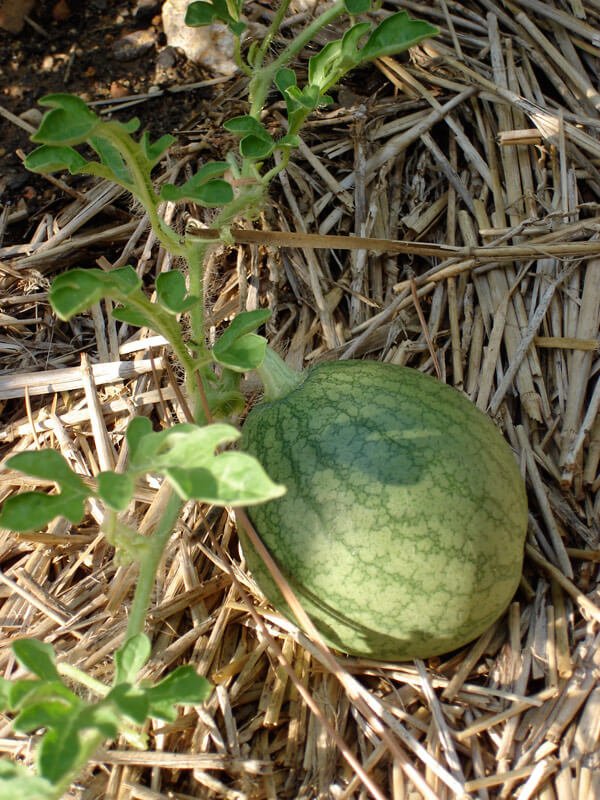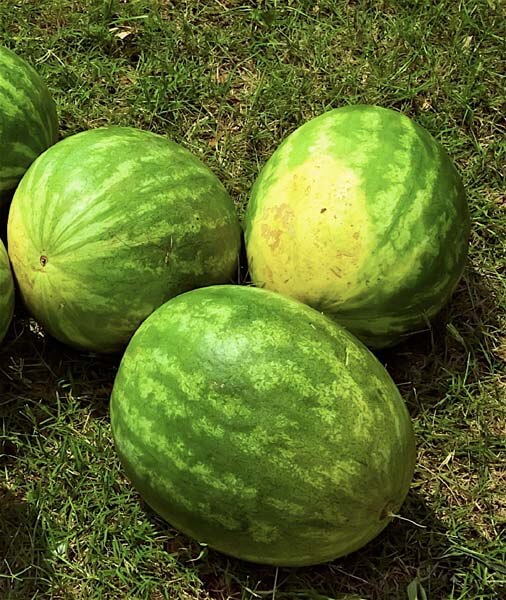Homegrown watermelons are sweet, juicy summer fruits that require 2 to 3 months of warm weather to produce ripe melons. Like their cantaloupe cousins, watermelons need sustained heat, which can make growing them in northern regions more challenging, but not impossible. By using plastic mulch to warm the soil and floating row covers to trap warm air near plants, gardeners across the country can enjoy homegrown watermelons. It also helps to skip the seeds and start with strong watermelon plants from Bonnie Plants®, which puts you weeks closer to harvest. (Don’t settle for just any plants—look for the Bonnie logo.)
Nutritionists have found that watermelon should be part of many people’s diets because it contains vitamin C and antioxidants, including beta-carotene and lycopene. Watermelons combine refreshing flavor with excellent nutrition, containing no cholesterol and nearly no fat.
Quick Guide to Growing Watermelon
- Plant watermelon from late spring to early summer, once soil temperatures reach 70° F or above.
- Space watermelon 3 to 5 feet apart in nutrient-rich, well-drained soil with a pH of 6.0 to 6.8.
- Give plants a fabulous start to the growing season by improving native soil with several inches of aged compost or other rich organic matter.
- Consistent water supply is critical to growing huge flavorful watermelon; install a soaker hose or drip irrigation for best results. Avoid wetting the leaves.
- Watermelons have huge appetites. Keep them well-fed with a continuous supply of nutrients by using a slow-release fertilizer regularly.
- Keep young melons off the ground with a bed of straw.
- Harvest watermelons when they turn from bright to dull green. They should sound hollow when you knock on them.
Soil, Planting, and Care
Growing watermelons requires warm soil. Don't tuck plants into the garden until soil temperature is above 70 degrees F, which typically occurs about the time peonies bloom in northern zones. To be safe, wait until at least 2 weeks past your area's last frost date. Prior to planting, cover soil with black plastic to hasten soil warming. Because watermelons are heavy feeders, prepare your planting bed by adding seaweed, compost, or rotted manure, or amend the soil with aged compost-enriched Miracle-Gro® Performance Organics® All Purpose In-Ground Soil to improve soil texture and nutrition. For best nutrient uptake, the soil pH should be between 6 and 6.8, although the plants will tolerate a pH as low as 5.
Give watermelon vines plenty of room to roam, which usually means spacing plants 3 to 5 feet apart. After planting, cover seedlings with floating row covers to keep out insects and trap warm air near plants.
Watermelon vines bear male and female flowers. Don't be alarmed when some of the male flowers, which appear first, fall off shortly after they open; they are followed by female blossoms about a week later. The female flowers, which have a small swelling at the base of the flower, stay on the vine to bear fruit. When vines start to bear both male and female flowers, remove row covers.
Tackle weeds before vines start to run because it will be difficult to move among vines at a later stage without crushing them. Mulching soil under the vines helps suppress weeds and slows moisture evaporation.
Water plays an important role in keeping vines healthy and producing delicious fruit. Vines are most sensitive to drought during the time from planting to when fruits start to form. Avoid overhead watering. Soaker hoses or drip irrigation deliver water directly to soil, helping prevent possible spread of fungal diseases among wet foliage. Keep soil consistently moist, but not waterlogged, which will kill plants. It's typical for leaves to wilt under midday sun, but they shouldn't remain wilted into evening. Water vines early in the morning so leaves can dry before sunset, which will further help prevent fungal diseases.
Watermelons take a long time to mature, so be sure your plants are getting a steady source of nutrition throughout the growing season. Starting with nutrient-rich soil is the first step, but then you'll also want to feed them regularly with a premium quality continuous-release fertilizer such as Miracle-Gro® Performance Organics® Edibles Plant Nutrition Granules allowing label directions.
Keep ripening watermelon from direct contact with soil to prevent rot and protect fruit from pests and rodents. When fruit is about the size of a softball, place it on a bed of straw or cardboard. Setting fruit on a light-reflecting surface, such as aluminum foil, will concentrate heat and speed up ripening. If large critters, such as groundhogs, discover your melons, protect ripening fruits by covering them with laundry baskets weighted down with a few bricks.
Some gardeners like to switch fertilizer during the course of the growing season. To do this, use a fertilizer with more nitrogen than phosphorus and potassium during the period between planting and when the first flowers open. Once flowering begins, use a fertilizer with less nitrogen and more phosphorus and potassium, such as African violet food or liquid seaweed.
Some believe that pinching off a vine's growing shoots as watermelons start to ripen will cause the plant to divert all its energies to fruit ripening. Recent research has shown this to be false. It's a vine's leaves that produce the sugars that sweeten fruit, so anything that reduces the total number of leaves available for sugar production actually lessens the sweetness of the melon.
In colder regions, remove any blossoms that start to develop within 50 days of your area's first average frost date. This will help ensure that remaining, larger fruits will ripen before frost.
Troubleshooting
Watermelons are in the same plant family as squash and cucumbers, but they do not cross-pollinate successfully. Your garden will depend on bees to pollinate the flowers, so cool, cloudy weather in the spring will slow down their development, as bees are less active in such conditions. Be patient until the weather warms.
Fungal diseases can multiple rapidly on melon leaves. Alternaria leaf spot, anthracnose, and gummy stem blight produce spots on leaves, while stem blight also forms bleached or tan sections on stems and rot on fruit. Downy mildew causes yellow or pale green leaf spots, while powdery mildew produces white spots on leaves. Treat fungal diseases with fungicides. Check with your local garden center or Extension Service to learn which fungicides are approved in your state for the disease you're fighting.
Also be on the lookout for pests. Melon aphids, for example, can quickly colonize a vine, so inspect leaf undersides daily. If you spot aphids, treat them with insecticidal soap. Spotted and striped cucumber beetles can attack vines, transmitting bacterial wilt disease, which causes vines to collapse without chance of recovery. Treat adult beetles with rotenone or a pyrethrum-based insecticide; apply at dusk to avoid harming honey bees.
For advice on how to control pests and diseases in your garden, contact your regional Extension service.
Harvest and Storage
Watermelons typically ripen over two weeks. As soon as one melon is ripe, the others won't be far behind. About a week before a melon is ripe, water only as necessary to keep vines from wilting. Withholding water causes sugars to concentrate in the fruit. Too much water reduces sweetness.You can judge a watermelon's ripeness by its skin colour. The rind changes from a bright to a dull green, and the part that touches the soil shifts from greenish white or straw yellow to rich, creamy yellow. Gardeners also judge a watermelon's ripeness by rapping on the skin and listening for a low-pitched thud. Tune your ear to the incorrect sound by rapping on a few fruits that aren't ripe. Underripe fruits resonate with a high-pitched, tinny sound.
Watermelons will keep 2 to 3 weeks unrefrigerated. Place them in a cool basement to increase their holding time. After cutting, refrigerate unused portions. If you have extra melon on hand, dice or cut the flesh into balls and freeze for slushies.




FAQs
How do you know when a watermelon is ready to pick?
Ripe watermelons twist easily off the vine. If a melon does not separate easily when twisted, it likely is not ripe yet.
Another sign of ripeness is the color of the underside of the melon. When it changes from white to a rich yellow, the watermelon is usually ready to harvest.
Will a watermelon get sweeter after it is harvested?
No. Watermelons stop ripening once they are removed from the vine. They should be harvested when they reach the desired level of ripeness.
How can you tell if a watermelon will be sweet?
A hollow sound when thumping a watermelon is a sign of sweetness. If the melon sounds hollow, it is likely sweet and ready to enjoy.
How should watermelons be stored?
Whole watermelons should be stored in a cool place. If a refrigerator is not available, watermelons can be cooled in a clean creek or in an ice chest.




 Herbs
Herbs
 Vegetables
Vegetables
 Fruit
Fruit
 Flowers
Flowers
 Succulents
Succulents


